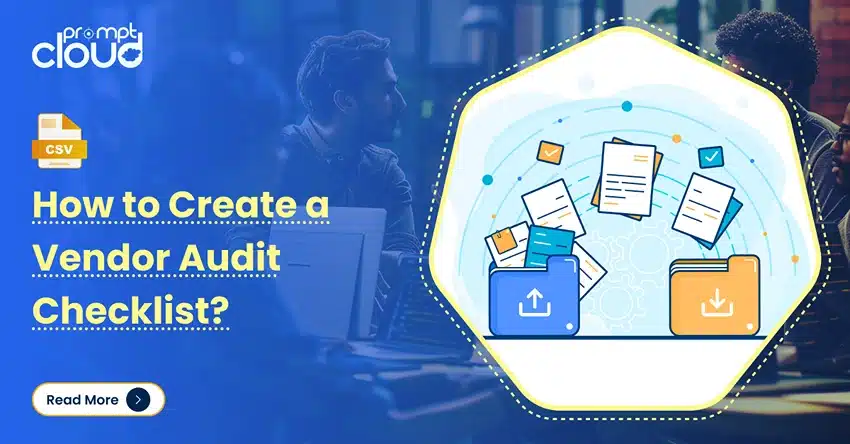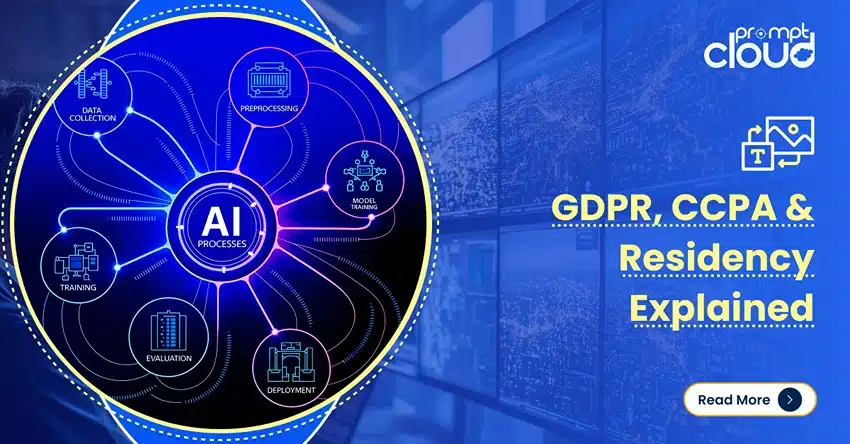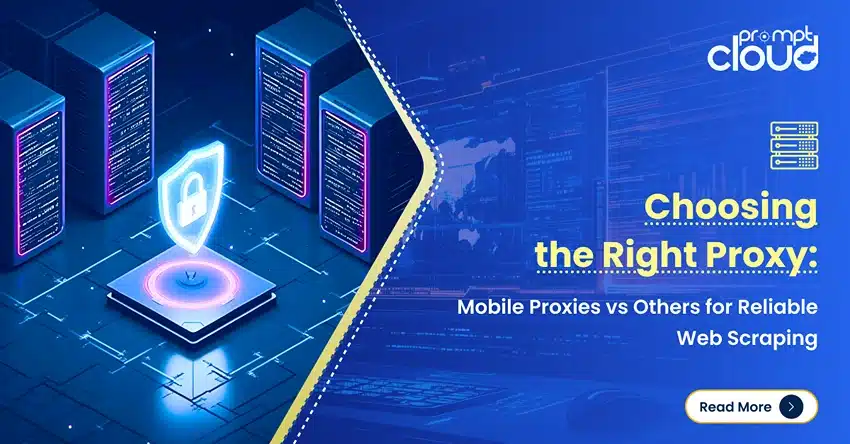
**TL;DR** Mobile proxies offer unmatched reliability, but they’re also expensive and have bandwidth limits. This article compares mobile proxies with datacenter and residential alternatives—so you know when to use which, what risks to expect, and how to pick the best mobile proxy setup for your use case.
Why Proxy Choice Impacts Scraping Success
Pick the wrong proxy and your crawler stalls: more bans, missing fields, and jittery dashboards. Pick the right one and you get stable sessions, clean HTML/JSON, and predictable throughput. Proxy type directly determines trust level, block rate, cost, and how much engineering you’ll spend firefighting.
Not all proxies are treated the same
Web defenses score traffic by “how human it looks.” That score depends on the IP’s reputation and context:
- Mobile proxy traffic inherits trust from real 4G/5G carrier networks shared by many users; individual requests are harder to single out.
- Residential IPs look like home users—good baseline trust but more variable quality.
- Datacenter IPs are fast and cheap but easy to fingerprint; many targets throttle or block them aggressively.
Result: the same scraper can pass or fail depending solely on the IP class behind it.
What’s really at risk with the wrong proxy?
- Higher block/solve rates: More CAPTCHA walls, 302 loops, soft-blocks, and empty payloads.
- Noisy data & gaps: Missing prices, partial reviews, truncated lists—bad inputs poison analysis.
- Latency spikes & crawl flakiness: Over‑zealous retries and timeouts ruin SLAs and freshness.
- Compliance risk: Poorly sourced IPs and reckless rotation patterns invite takedowns.
- Hidden costs: Extra proxy bandwidth, more headless browsers, and hours of incident triage.
A mobile proxy often cuts ban rates on hardened targets (apps, mobile‑first sites, marketplaces), but it’s not a silver bullet. It trades cost and bandwidth for reliability. Residential often balances price and pass‑through. The datacenter shines for volume and speed where defenses are light.
Bottom line: choose proxies to match the defenses you face, not just the price. For aggressive anti‑bot, lean mobile (or high‑quality residential with smart rotation). For broad, low‑risk crawling at scale, datacenters may win on throughput-per-dollar. And in many production stacks, the optimal path is hybrid routing: start with residential or datacenter, auto‑escalate to mobile proxy only when pages or endpoints prove stubborn.
Want expert-built scraping support?
Want reliable, structured Temu data without worrying about scraper breakage or noisy signals? Talk to our team and see how PromptCloud delivers production-ready ecommerce intelligence at scale.
What Is a Mobile Proxy?
A mobile proxy sends your requests out over real cellular networks—3G, 4G, or 5G—through SIM‑powered devices. To the website, it looks like the traffic is coming from an actual phone on a carrier’s network, not a data center or a home router. In other words, it resembles a normal person browsing.
This matters because websites (and their anti-bot systems) see mobile traffic as more legitimate. Mobile IPs rotate frequently, share IP ranges across thousands of users, and inherit high trust scores from mobile carriers. It’s far harder for anti-scraping tech to distinguish your crawler from normal user behavior when it’s masked by a mobile proxy.
How Mobile Proxies Work
- Your scraper sends a request to a proxy provider
- That request is routed through a real SIM-enabled mobile device
- The target site sees the IP of the mobile carrier—not your scraper, and not a datacenter or VPN
- These IPs rotate naturally, often every few minutes, simulating normal browsing behavior
It’s not just masking—it’s stealth by design. Because mobile proxies ride on real network infrastructure used by real humans, they blend in better than most alternatives.
How It Differs from Other Proxy Types
| Feature | Mobile Proxy | Residential Proxy | Datacenter Proxy |
| IP Origin | 4G/5G device via telecom carrier | Home user network via ISP | Server in a data center |
| Trust Score | Highest | Medium | Low |
| IP Rotation | Frequent, automatic | Provider-controlled or sticky | Rare unless scripted |
| Ban Resistance | Very strong | Good | Weak |
| Speed | Moderate | Fast | Fastest |
| Price per GB | $$$ | $$ | $ |
| Best Used For | Evasion, stealth scraping | General-purpose crawling | Scale, public/light targets |
Mobile Proxy vs Datacenter vs Residential
Different targets call for different IP “camouflage.” Here’s a straight, side‑by‑side to help you pick the right lane.
Quick Comparison
| Feature / Criteria | Mobile Proxy | Residential Proxy | Datacenter Proxy |
| IP origin | Real 4G/5G carrier networks | Home ISPs (household routers) | Cloud/server farms |
| Trust level | Highest | Medium | Lowest |
| Ban resistance | Best (shared carrier ranges) | Good | Weak on hardened sites |
| Speed | Moderate | Fast | Fastest |
| Cost per GB | $$$ | $$ | $ |
| Rotation behavior | Frequent, natural (carrier churn) | Provider‑controlled (rotating or sticky sessions) | Scripted or fixed unless swapped |
| Ideal use cases | Hard targets, mobile/app views, geo‑strict pages | General web, shopping sites, SERPs, marketplaces | Public docs, blogs, catalogs, bulk crawling |
| Typical constraints | Bandwidth caps, higher price | Mixed pool quality, occasional noise | Fingerprinted ranges, easier to flag |
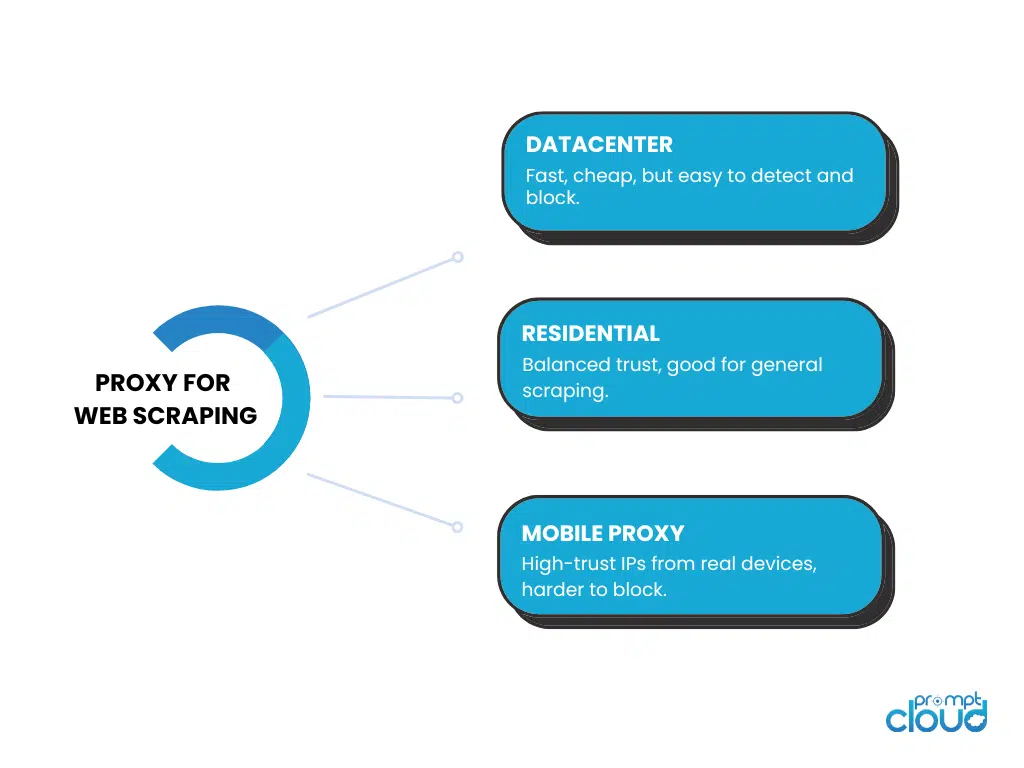
How to choose in real life
- Go Mobile when the site is aggressively defended, mobile‑first, or shows different content to app/mobile traffic. Also useful for fine geotargeting (e.g., US mobile proxy for state‑ or city‑level views).
- Go Residential when you need good pass‑through at sane cost. It’s the everyday workhorse for marketplaces, price checks, and review pulls.
- Go Datacenter when targets are lightly defended and you need throughput: sitemaps, blogs, product catalogs, documentation—anything public and simple.
A practical pattern that works
Run a hybrid policy:
- Start with datacenter for speed.
- Auto‑fallback to residential on block patterns (CAPTCHAs, 302 loops, empty payloads).
- Escalate to mobile only for stubborn endpoints or geo‑locked views.
This keeps costs down while preserving reliability where it matters.
When to Use a Mobile Proxy
A mobile proxy is not your default—it’s your ace. Use it when stealth, trust, and geo-specific accuracy matter more than cost or speed.
Geotargeted Access (e.g., US Mobile Proxy)
Some websites change prices, listings, or access rules based on specific mobile regions. A US mobile proxy lets you appear as a real device in that state, city, or carrier network—far more convincing than a VPN or datacenter IP. This is especially useful for scraping:
- Region-locked listings (classifieds, local eCommerce, real estate)
- App-only pricing models or promotions
- Hyperlocal search result variations
If your competitor’s price only shows up in a Miami ZIP code on a mobile browser—this is how you see it.
Related: Top Web Scraping Applications – A Guide by PromptCloud.
Further reading: PromptCloud eCommerce & Retail Data — see how proxy strategy impacts pricing, availability, and review feeds.
Scraping Mobile-Optimized or App-Based Sites
Some websites serve completely different content based on the device or connection type. These mobile experiences often:
- Load different product variants
- Use JS frameworks optimized for mobile
- Have exclusive reviews, ratings, or CTA logic
Using a mobile proxy allows your scraper to blend in with actual user traffic and extract data that’s otherwise hidden, even from regular residential IPs.
[Example: Mobile-only views on Etsy, Amazon, or niche DTC storefronts]
Avoiding Rate Limits and Anti-Bot Systems
Websites are getting smarter. Fingerprints, IP history, browser patterns, time-of-day activity—everything’s logged. A mobile proxy helps you:
- Avoid IP bans tied to suspicious automation
Spread requests across legitimate carrier ranges - Rotate clean IPs more naturally than scripting headers
The difference? Less CAPTCHA, fewer soft blocks, and more data per request.
Read Mozilla’s guide on user-agent and fingerprinting behaviors to understand how proxies influence bot detection.
When Mobile Proxies Are Overkill
Mobile proxies are powerful—but not always practical. In many scraping workflows, they’re too expensive, too slow, or just unnecessary.
Budget-Conscious High-Volume Scraping
If you’re scraping large amounts of publicly available content—think product listings, open forums, public directories, or news aggregators—mobile proxies are overkill. Datacenter or residential proxies can handle this volume more affordably.
Example: crawling 10,000 blog articles or scraping public product catalogs every hour doesn’t justify the cost of rotating through high-trust mobile IPs.
See also: Top 10 Traps to Avoid When Scraping News Aggregators
Low-Defended, High-Throughput Targets
Some websites don’t fight scraping. If you can load them in incognito mode without issues or they don’t even check for headers like User-Agent, you’re not dealing with aggressive defenses. Using mobile proxies here is like driving a tank to pick up groceries.
- Static websites
- Company directories
- Old-school B2B portals
- Sitemap-based targets
For these, datacenter proxies win on speed, cost, and efficiency.
Choosing the Best Mobile Proxy Setup
Mobile proxies aren’t “plug and play.” The right setup depends on how hard the target fights back, where you need to appear from, and how much you’ll push per minute. Use this checklist to lock in reliability without burning budget.
Pool Size, Carrier Mix, and Geo Depth
- Pool size: Aim for thousands of active mobile IPs per target to avoid reuse patterns.
- Carrier diversity: Mix top carriers (e.g., multiple US networks) to reduce fingerprint clustering.
- Geo depth: Go beyond country. Ask for state/city routing when results or prices vary locally.
- ASN variety: Multiple ASNs per region lowers the odds of range-level blocks.
Rotation Logic That Matches the Site
- Time‑based rotation: 1–10 minutes per IP for browsing‑like traffic; shorten for API‑like endpoints.
- Event‑based rotation: Rotate on soft block, CAPTCHA, or unusual latency spikes.
- Sticky sessions: Keep a session when you’re paginating or adding to cart; rotate between tasks.
- Concurrency caps: Don’t blast 50 threads through one SIM pool. Spread load across carriers.
Session Stability and Browser Signals
- Session cookies: Reuse per listing/search flow to mimic real users.
- Header hygiene: Keep User-Agent, Accept-Language, and viewport consistent within a session.
- TLS/JAE (fingerprint) stability: Sudden header or cipher shifts trigger defenses.
- Mobile rendering: Use mobile UA and viewport when scraping truly mobile views.
Reference: MDN on User‑Agent behavior and why consistency matters.
Bandwidth & Throughput Planning
- Budget for images: Mobile pages are image‑heavy; block media where not needed.
- Headless cost control: Cache static assets; prefer lightweight navigations; avoid full replay.
- Backoff rules: Exponential backoff on 429/5xx prevents escalation to hard bans.
- Warmup windows: Ramp traffic gradually; cold spikes look robotic.
Quality, Compliance, and Auditability
- Sourcing transparency: SIM‑based, consented traffic only. Get documentation.
- Robots and ToS awareness: Respect disallow paths and frequency caps; log evidence.
- PII avoidance: Exclude personal data fields from collection by design.
- Event logs: Keep request/response codes, selector drift alerts, and block markers for audits.
Provider Due Diligence (Red Flags)
- Vague SIM sourcing or reseller chains you can’t verify.
- Single‑carrier pools for a whole country.
- No sticky support, no event‑based rotation, or missing per‑job concurrency limits.
- Opaque billing (no GB/request breakdowns, surprise overage fees).
Test Plan Before You Commit
- Pilot on three pages: a product page, a search results page, and a review page.
- Measure pass rate: % of pages with full field coverage (not just status 200).
- Track field completeness: Prices, variants, shipping, and reviews present and parsed.
- Cost per successful page: GB + runtime + maintenance divided by valid rows.
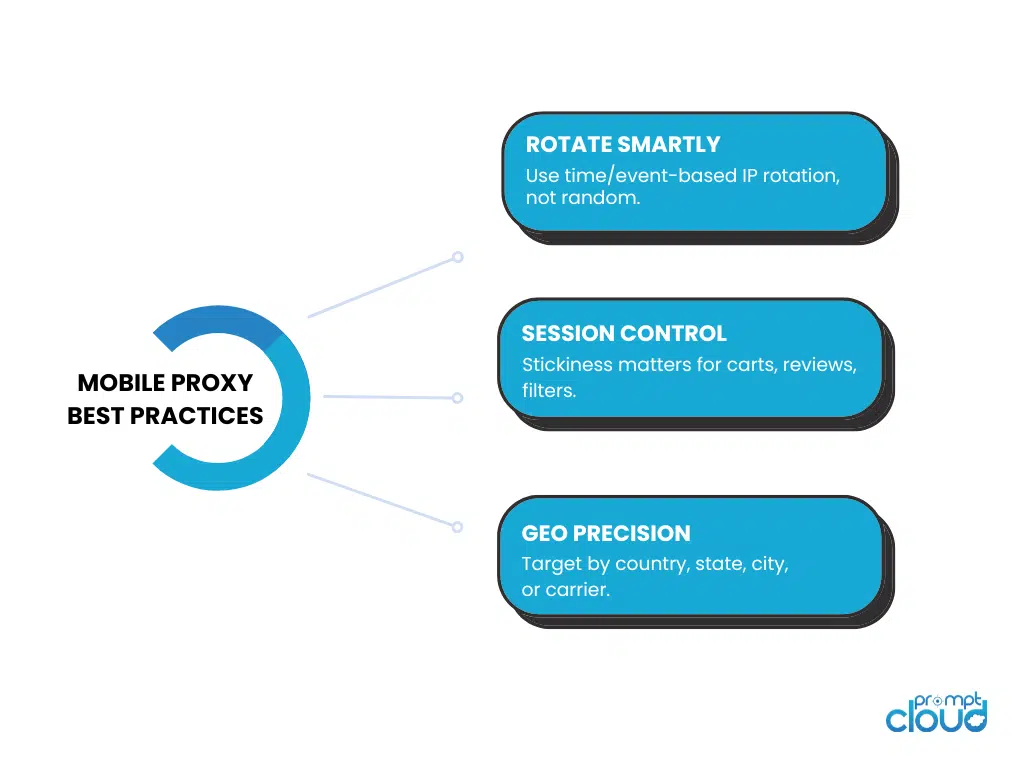
How PromptCloud Handles Proxy Logic
You don’t need to manage proxies yourself. When you use PromptCloud, proxy selection, rotation, escalation, and retry logic are built into the pipeline—so you get the data you need, even from targets that fight back.
Hybrid Routing Logic by Default
PromptCloud doesn’t guess which proxy will work—it observes, reacts, and escalates intelligently:
- Starts with datacenter or residential for speed and cost-efficiency.
- Detects failure patterns (e.g., CAPTCHAs, redirects, 403s, missing fields).
- Auto-switches to mobile proxy only for stubborn endpoints or geo-locked content.
This hybrid approach ensures low cost per record without compromising pass rate.
Geo Control When It Matters
- Need to scrape based on location? PromptCloud supports country, state, and city-level routing.
- Want US mobile proxy traffic only? We lock sessions to real U.S. SIM-based devices.
- Need fine-grained targeting? We rotate carriers, ASNs, and session IDs—without fingerprint collision.
This isn’t just proxy access. It’s controlled, repeatable targeting—especially useful for location-sensitive ecommerce, real estate, or mobile search engines.
Automated Retrying, Monitoring, and QA
- Auto-retry logic for timed-out, blocked, or partial requests
- Block pattern detection (CAPTCHA frequency, loop redirects, field loss)
- Field-level monitoring for completeness (not just HTTP 200)
- QA reporting on coverage, freshness, and deduplication
- No IP management needed from your team—just define the targets and receive data
Where Mobile Proxy Strategy Is Headed: Advanced Use Cases and Risks
Most articles stop at basic comparisons—price, speed, stealth. Let’s go beyond the basics.
Proxy Pool Decay Is Real. Are You Tracking It?
Mobile proxies don’t stay clean forever. Carriers shift IP blocks. SIM cards get flagged. Performance drops quietly. If your proxy provider rotates through 5,000 IPs but 1,200 of them have rising CAPTCHA failure or 403 rates, you need to know before it impacts your delivery pipeline.
What to monitor:
- Blocked request % per IP or SIM group
- Spike in latency or timeouts
- Selector coverage drops (HTML loads, but fields are empty)
- “Soft blocks” – payloads missing core fields (e.g., reviews missing but page returns 200)
Solution: Implement a proxy pool health scoring system: auto-label IPs by success rate, field coverage, and failure patterns. Remove low-performers or reassign them to fallback pools.
Dynamic Proxy Orchestration (Not Static Rules)
Stop hardcoding proxy types. Use logic that adapts live. Example orchestration pattern:
- Start with datacenter proxy
- If >5% 403s or >3% field loss over 1,000 requests → switch to residential
- If CAPTCHA solve time >2 sec average or block rate >8% → escalate to mobile proxy
Add a decay-aware retry layer: penalize flaky proxies, reward stable ones.
Privacy & Compliance for Mobile Proxy Use
Privacy laws are evolving faster than scraping strategies. If your provider can’t show how their mobile IPs are sourced, you might be using unconsented traffic.
Ask for:
- SIM sourcing documentation
- Regional consent policy mapping
- Exclusion of PII fields in your crawl configs
- Full list of ASN/carrier routes used in each geo (especially US and EU)
Scraping is legal—but sourcing matters. Teams using US mobile proxy pools for price tracking in regulated markets should have clean audit trails.
Mobile Proxies for UX Testing, Not Just Scraping
Real mobile IPs reveal content that even residential proxies miss. Some sites:
- Change layout, CTA, or pricing on mobile
- Deliver app-exclusive discounts
- Hide fields behind mobile-only JavaScript blocks
- Load different images or descriptions for small viewports
Scraping via true mobile proxies allows you to test this version of the web—exactly how real users see it. This is crucial for:
- UX regression testing
- Brand integrity monitoring
- Mobile SEO and SERP comparison audits
You can also use mobile proxies for testing competitive visibility. Brands often personalize product listings or ad placements based on device type, location, or mobile carrier. By routing through mobile IPs, you can simulate a wide range of user conditions—seeing exactly how your brand (or your competitors) show up in mobile-first experiences.
It’s also a smart way to monitor app-exclusive content, even if the site doesn’t serve it to desktops. Some DTC brands or marketplaces quietly A/B test layout changes or pricing tiers via mobile UX. Scraping those variations can expose hidden trends long before they go public.
Want expert-built scraping support?
Want reliable, structured Temu data without worrying about scraper breakage or noisy signals? Talk to our team and see how PromptCloud delivers production-ready ecommerce intelligence at scale.
FAQs
1. What is a mobile proxy and how does it work?
A mobile proxy routes your web traffic through a real mobile device (4G/5G) using SIM cards provided by telecom carriers. This makes your scraping requests appear like they’re coming from everyday smartphone users, giving you higher trust and a lower block rate compared to datacenter or residential proxies.
2. When should I use a mobile proxy instead of other types?
Use mobile proxies when you’re dealing with aggressive anti-bot systems, mobile-only experiences, or geo-targeted content. They’re ideal for scraping app-first sites, mobile SERPs, or marketplaces that throttle IPs heavily. If you’re targeting platforms like Etsy, TikTok, or localized eCommerce, a US mobile proxy might be essential.
3. Are mobile proxies legal to use for web scraping?
Yes—when used responsibly. Always avoid collecting personal information, and make sure your provider sources IPs ethically and transparently. At PromptCloud, our scraping workflows respect robots.txt, regional privacy laws, and exclude personally identifiable data by design.
4. Are mobile proxies better than residential proxies?
They’re more evasive, but also more expensive. Mobile proxies offer higher trust and better block resistance, while residential proxies provide a strong middle ground for most scraping jobs. The best strategy often involves both—using residential as default and escalating to mobile only when needed.
5. How do I choose the best mobile proxy provider?
Look for transparency in IP sourcing, carrier variety, rotation logic, session controls, and compliance policies. Avoid vendors that can’t explain where their mobile IPs come from or how they manage pool health. PromptCloud integrates mobile proxy routing with full QA, fallback logic, and delivery in your preferred format.










